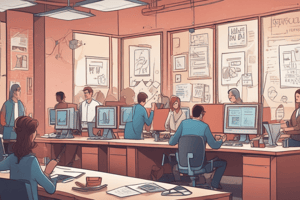Podcast
Questions and Answers
What does job enlargement involve?
What does job enlargement involve?
- Creating new job positions
- Horizontal expansion by adding extra tasks (correct)
- Vertical expansion of job responsibilities
- Reducing the number of job duties
Which concept refers to increasing responsibilities and autonomy in a job?
Which concept refers to increasing responsibilities and autonomy in a job?
- Job Design
- Job Enrichment (correct)
- Job Enlargement
- Job Rotation
According to Maslow's Hierarchy of Needs, what role does money primarily satisfy?
According to Maslow's Hierarchy of Needs, what role does money primarily satisfy?
- Psychological needs
- Self-actualization needs
- Basic physiological needs (correct)
- Esteem needs
Which of the following is NOT one of the core dimensions of the Job Characteristics Model?
Which of the following is NOT one of the core dimensions of the Job Characteristics Model?
What is a significant misconception about managers' role in motivation?
What is a significant misconception about managers' role in motivation?
What is the first step in the motivation process from an organizational perspective?
What is the first step in the motivation process from an organizational perspective?
Which of the following statements is true regarding money as a motivator?
Which of the following statements is true regarding money as a motivator?
What is the outcome of the motivation process following satisfaction or dissatisfaction?
What is the outcome of the motivation process following satisfaction or dissatisfaction?
Which aspect does job design focus on enhancing?
Which aspect does job design focus on enhancing?
What should motivation be understood as by employees?
What should motivation be understood as by employees?
What are the three factors that Vroom's Expectancy Theory identifies as influencing motivation?
What are the three factors that Vroom's Expectancy Theory identifies as influencing motivation?
Which of the following theories condenses Maslow's five human needs into three categories?
Which of the following theories condenses Maslow's five human needs into three categories?
According to Herzberg's Two-Factor Theory, which of the following is classified as a hygiene factor?
According to Herzberg's Two-Factor Theory, which of the following is classified as a hygiene factor?
What does the concept of reinforcement theory focus on?
What does the concept of reinforcement theory focus on?
Which of the following best defines motivation according to the content theories?
Which of the following best defines motivation according to the content theories?
In which theory are achievement, affiliation, and power identified as dominant motivating drivers?
In which theory are achievement, affiliation, and power identified as dominant motivating drivers?
In Herzberg's Two-Factor Theory, which factors lead to increased job satisfaction?
In Herzberg's Two-Factor Theory, which factors lead to increased job satisfaction?
What is the primary focus of process theories of motivation?
What is the primary focus of process theories of motivation?
Which motivation theory emphasizes fairness and equality in the workplace?
Which motivation theory emphasizes fairness and equality in the workplace?
What happens to a behavior that is followed by positive consequences?
What happens to a behavior that is followed by positive consequences?
Which of the following is NOT a category in Alderfer's ERG Theory?
Which of the following is NOT a category in Alderfer's ERG Theory?
Which of the following best describes the concept of motivation in the workforce?
Which of the following best describes the concept of motivation in the workforce?
Which theory focuses on measurable, performance-related behaviors?
Which theory focuses on measurable, performance-related behaviors?
Flashcards are hidden until you start studying
Study Notes
Job Design and Motivation Concepts
- Job Enlargement: Expands a job horizontally by adding extra tasks and duties.
- Job Enrichment: Offers vertical growth by increasing responsibilities and autonomy.
- Job Design: Focuses on creating roles that motivate employees, recognizing that motivation is intrinsic.
- Motivation Definition: The willingness of employees to achieve organizational goals, heavily influenced by personal interests.
Motivation Theories and Models
- Job Characteristics Model: Identifies five core dimensions (skill variety, task identity, task significance, autonomy, feedback) crucial for creating motivations through psychological states.
- Maslow's Hierarchy of Needs: Suggests basic physiological needs must be satisfied first; however, money only fulfills short-term needs and does not sustain long-term motivation.
- Herzberg's Two-Factor Theory: Classifies money as a hygiene factor that prevents dissatisfaction but does not enhance satisfaction if present.
- Alderfer's ERG Theory: Condenses Maslow's hierarchy into three levels: Existence, Relatedness, and Growth.
- McClelland's Acquired Needs Theory: Identifies three major motivators: Achievement, Affiliation, and Power, shaping employee motivation.
Motivation Process
- Motivation Process Steps: Involves a cycle: Need → Motive → Behaviour → Consequence → Satisfaction/Dissatisfaction → Feedback.
- Performance Equation: Motivation x Ability x Opportunity = Performance.
- Reinforcement Theory: Emphasizes that behaviour changes based on consequences, encouraging desirable actions with positive reinforcement and reducing undesirable behaviours with negative reinforcement.
Motivation and Performance
- Influential Factors: Identifies critical observable performance-related behaviours and measures their occurrences.
- Reinforcement Principle: Positive outcomes increase the frequency of specific behaviours, while negative outcomes decrease them.
- Management Applications: Utilize reinforcement strategies: positive/negative reinforcement and distinct schedules to enhance motivation.
Process and Content Theories
- Content Theories: Focus on identifying needs influencing motivation, including Maslow's, ERG, and Herzberg's theories.
- Process Theories: Concentrate on goal-setting processes and satisfaction evaluation, including Equity Theory and Vroom's Expectancy Theory, which examines motivation through Expectancy, Instrumentality, and Valence.
Key Takeaways
- Understanding motivation requires a blend of recognizing internal drivers and implementing strategic job design methods.
- Money plays a role but is not the sole motivator for long-term employee engagement and satisfaction.
- Behaviour management through reinforcement can significantly impact workplace performance and motivation.
Studying That Suits You
Use AI to generate personalized quizzes and flashcards to suit your learning preferences.




